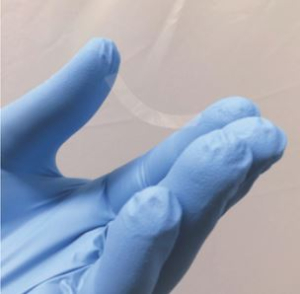Tired of lugging that heavy laptop in your padded backpack? Here’s an idea: When you’re finished using your laptop, just roll it up, fold it, stick it in your back pocket and bolt. That’s the incredible future being created in a UH Cullen College of Engineering laboratory – a flexible, thin-film transistor (TFT) that may one day make your current laptop a dinosaur.
“Think of it as a roll of Saran Wrap or a jelly roll” said Venkat Selvamanickam (Selva), M.D. Anderson Chair Professor of mechanical engineering. Jae-Hyun Ryou, assistant professor of mechanical engineering, added, “You won’t need a big truck to buy a 60-inch television set, if you can just roll it up and take it with you.”
Their work is highlighted in the journal Advanced Electronics Materials in their article “High-Performance Flexible Thin-Film Transistors Based on Single-Crystal-Like Germanium on Glass.”
The bright past and flexible future
In the past we came to know TFT technology through LCD (liquid crystal display) monitors and television sets as the brightest, prettiest ones. Each pixel in an LCD has a transistor that turns it on and off, creating those vivid colors.
“Each pixel has its own red, green or blue elements,” explained Ryou. “So if a pixel needs to have the color red in a certain spot, the TFT turns on the red and turns off the blue and green."
But those are yesterday’s transistors. The future is flexible.
“Ordinarily transistors are made of wafer material that will break if you try to roll or bend them, but if we can make flexible and bendable TFTs then we can make flexible computers,” said Ryou.
Switching on the transistor
Ying Gao, postdoctoral fellow in mechanical engineering, developed the idea of how to make the TFTs flexible while she was still a Ph.D. student studying with Selva. She says superconductors inspired her to use a highly-aligned crystalline layer on a metal as a base for the TFTs.
“We already have this technology,” said Gao. But she replaced the bottom, rigid metal layer with flexible glass. This pliable, thin glass is the basis for building the TFT, giving it flexibility. The performance comes from the second and third layers.
The third layer that makes the TFT work, is made of the silicon-like chemical element germanium. “The germanium is very high quality with high mobility,” said Gao. The second layer is an intermediate buffer film. “If we don’t have this intermediate layer it will cause low performance of the TFT.”
Gao’s ideas leapt off the drawing board and into fabrication with Ryou’s team, led by mechanical engineering Ph.D. student Mojtaba Asadirad.
With those three layers together, they created a high-performance transistor that is flexible and cost-effective, becoming what Selva calls “simple, elegant and easy to make.”
“It’s so easily scalable,” said Selva. One day he says it will be possible to put the glass on a big roll, like the Saran Wrap, feed it into a machine and it will come out with transistors on the other end.
Stretching the imagination
Much like the three-dimensional, bendable screens in the movie “Minority Report,” Selva talks about looking at a map on a computerized screen that you just stretch and bend to see the picture in greater detail.
“Just imagine being able to pull out your screen and make it as big as a conference table,” said Selva. He said it makes perfect sense to be used first by the military, so soldiers could carry maps from one location to another. “They could roll this out in the middle of the desert, make it as big as they need it to be,” he said.
For consumer use, the possibilities are endless.
With phone screens getting bigger and bigger, it’s a good bet that people don’t like squinting while they’re pouring over a story they might be reading online. With this new technology, if the display itself can be expanded and still kept compact enough to carry in your pocket, it would change not only their screen view, but along with it, the world view of electronics and engineering.

